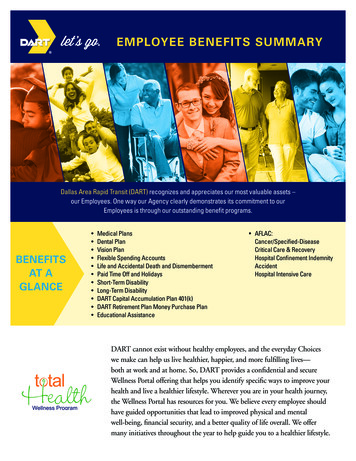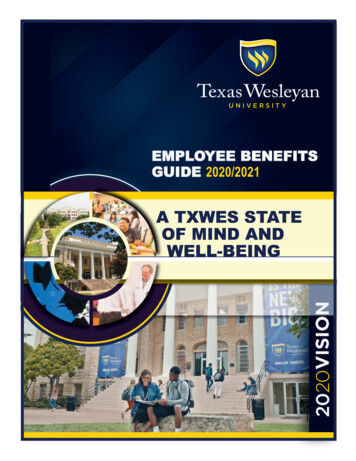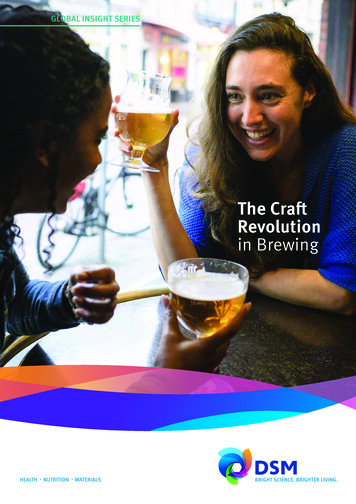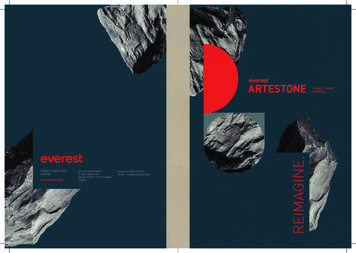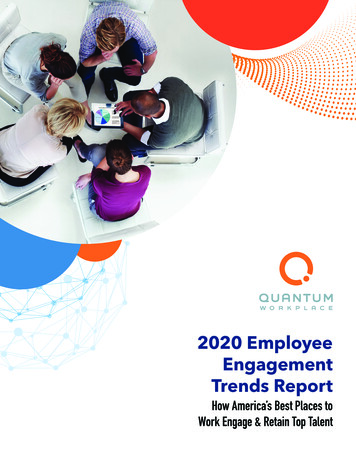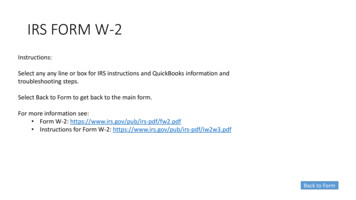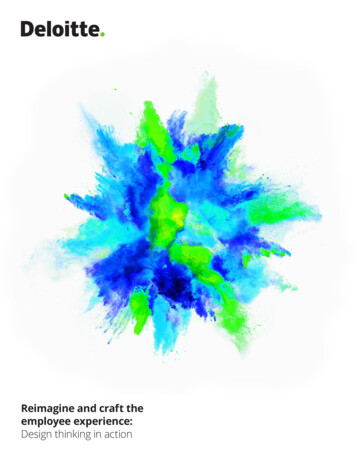
Transcription
Reimagine and craft theemployee experience:Design thinking in action
Reimagine and craft the employee experience: Design thinking in actionAs used in this document, “Deloitte” means Deloitte Consulting LLP, a subsidiary of Deloitte LLP. Pleasesee www.deloitte.com/us/about for a detailed description of our legal structure. Certain services may notbe available to attest clients under the rules and regulations of public accounting.
Reimagine and craft the employee experience: Design thinking in actionReimagine and craft theemployee experience:Design thinking in actionThe business imperativeYour organization is responding to major business and workforce disruptions,driving changes to the way your enterprise runs and intensifying the needto focus on the customer experience to drive growth. As a leader in HR,you understand the critical linkage between the employee experience, yourcompany’s business strategy, and customer service. But, how to forge iteffectively?The answer may lie in applying design thinking to reimagine and craft theemployee experience to help generate higher engagement, satisfaction, andstrategic alignment to drive brand differentiation, customer service excellence,and growth.While the term “employee experience” has gained traction, in this context“employee” must really consider the end-to-end workforce that includescandidates, employees, contingent workers, and alumni.Why is this so important? Because studies have documented a clearstatistical relationship between increases in frontline engagement, increases incustomer service, and revenue growth.1 So whether your team is focused onstrategy, process transformation, or implementing new technology, applyingdesign thinking to reimagine and craft the employee experience is key to drivingsustainable business performance.Design for the moments that matterBersin by Deloitte, Deloitte Consulting LLP, developed The Simply IrresistibleOrganization model defining the end-to-end, irresistible employeeexperience. We have since married this model with a tested, customer-centricexperience approach that brings together engagement, experience, and results.In this perspective, we explore several examples of ways that HR professionalscan apply design thinking to imagine, design, and deliver an experience thatdelights the workforce at the “moments that matter” across their interactionswith the organization.1
Reimagine and craft the employee experience: Design thinking in actionDeloitte’s employee experience frameworkAlignFocusExecuteMeasureDevelop experience vision alignedwith business and talent strategiesDefine and brand theend-to-end experienceImplement prioritized initiativesroadmap with targeted sprintsCapture value of improvingexperience and find enhancementsCrafting the workforce experience to achieveThe simply irresistible organization Meaningful workSupportivemanagementPositive WorkenvironmentGrowth opportunityTrust in leadershipAutonomyClear andtransparent goalsFlexible workenvironmentTraining and supporton the jobMission and purposeSelection to fitCoachingHumanistic workplaceFacilitated talentmobilityContinuousinvestment in peopleSmall, empoweredteamsInvestment indevelopment ofmanagersCulture of recognitionSelf-directed,dynamic learningTransparency andhonestyTime for slackAgile performancemanagementFair, inclusive, diversework environmentHigh-impactlearning cultureInspirationCollaboration and connectionSource: Deloitte Consulting LLPShifting from process thinking toexperience thinkingDesign thinking places the “customer” inthe center of the design and has beeninstrumental in creating the kinds of easy,digital experiences that people expect intheir daily lives for everything from orderingproducts to paying bills to connecting withfriends on social media. Just as numerousconsumer-facing processes and interactionshave been retooled and simplified to providea more satisfying customer experience, HRcan begin to shift its approaches as well.The idea is to move from a process-drivenmindset to a mindset that always beginswith the experience for the HR customer—who could be a candidate, employee,contingent worker, or even alumni. So, forexample, instead of thinking in process2terms, “What do we need new-hires to doon their first day?” HR thinks in experienceterms: “What do we want a new employee’sfirst day to be like?”HR leaders are rapidly adopting thisexperience-oriented approach and applyingit to truly rethink how HR work happens.Design thinking helps focus on the needsof customers when shaping an experiencethat’s easy, intuitive, and enables customersto achieve their goals. It also helps defineHR through the lens of the workforce’s“journey” across processes to shape thedesired impression and feeling amongthe workforce, ultimately helping to createexperiences that are meaningful and ableto make the biggest impact at the momentsthat truly matter for the individual. So, it’snot only thinking about an employee’sfirst day but also the total onboardingexperience, and all of the ongoinginteractions between that employee and HRthroughout his or her career and even as aretiree or alum.Deloitte’s Global Human CapitalTrends 20172 report revealed thatnearly 80 percent of executives ratedemployee experience very important(42 percent) or important (38 percent),but only 22 percent reported thattheir companies were excellent atbuilding a differentiated employeeexperience.
Reimagine and craft the employee experience: Design thinking in actionThree key principles: empathize,envision, experimentWhile design thinking has manydefinitions and various possible paths toimplementation, three principles stand outas fundamental to effectively engaging theworkforce as customers:01. Empathize: Understand the workforceand the problems they face. Thefoundation of this principle is the abilityto empathize with segments of yourworkforce. Empathy is what allows usto share the experiences and feelingsof others, creating opportunities forengagement. Design thinkers developpersonas (representations of thequalities and characteristics of typicalcustomers) drawn from the breadth anddiversity of their workforce population.Journey maps based on these personasdocument experiences at every step ofan activity to identify the moments thatmatter most and to provide clarity onthe problems that need solving.02. Envision: Generate a variety ofoptions and shape them intopotential solutions. This principleinvolves imagining the widest possiblerange of options through varioustechniques, rather than attempting todefine and evaluate a single “best” idea.Generating a variety of options movesstakeholders beyond the initial, obvioussolutions. Doing so also increases thepotential for innovation, especiallywhen performed as part of a team. Theideas with the most potential can thenbe prioritized and shaped into modelsready for testing.03. Experiment: Test potential solutionswith real customers, and refine themwith data and feedback. Testing ina real context while collecting bothqualitative and quantitative data enablesadditional empathy with customers,more precise definitions of theproblems, and continuous refinementof solutions. This step creates anopportunity for experimentation inHR while effectively managing theassociated risks.There are many examples of how HR canapply design thinking to reimagine and craftthe experience to drive sustainable businessperformance. Let’s look at a few: overallemployee experience strategy, HR processtransformation, HCM technology selection,HCM app development and HR OperationalServices.Design thinking in actionDesign thinking meets employeeexperience strategyIn our first example, design thinking isapplied to an employee experience strategy,an “outside-in” effort to understand theunique needs of each customer group HRserves and design differentiated interactionsto satisfy those needs. High-impact HRorganizations create experience strategiesto understand who their HR customersare, what they need, and the specific HRexperiences that matter most to them. Thegoal is to look beyond developing processesand focus on designing tailored experiencesfor each customer group, starting with themoments that matter most. Then, simple,intuitive HR processes and technologies aredeveloped to support those moments andthe overall experience.Customer experience strategies are meantto continually evolve. They can use models,prototypes, and multiple voices to design,test, and refine solutions to keep up withthe needs of customers. And they tend toincorporate learning gained from iteratingcustomer experience solutions quickly,revising ideas early and often. These sameprinciples apply to crafting the employeeexperience, where “employee” can mean thefull range of customers for HR: candidates,full time employees, leaders, contingentworkers, and alumni.A financial institution created an employeeexperience strategy as part of an overall HRtransformation to increase customer serviceand simplify HR processes. The design teamobserved and interviewed HR employeesand HR customers to identify priorityworkforce segments (personas) and theexperiences that mattered most to them.Questions like the following were especiallyeffective: Describe your typical day at work? What excites you about your job? What are the things that distract you andare pet peeves for you at work? When is a time you felt most empoweredto do your job?Based on its research, the team identifiedthe following customer personas: Manager delivering frontline impact onthe company’s success High Potential key to the future New Hire the company’s most importantinvestment Executive evaluating successNext the team created journey maps thatrevealed the moments that mattered mostto each of the customer personas. Thiseffort defined a set of initiatives to quicklybuild, test, and iterate to begin to achievethe customer experience vision.Where is the financial institution now?Continuing on its transformation journeyand reporting both a positive impact on theareas the employee experience strategytargeted— from brand differentiation tocustomer service excellence—and a returnon investment through process efficiency.Deloitte’s Global Human CapitalTrends 20163 research reveals that,typically, the more importance anorganization places on design thinkingand the more ready it is to embrace it,the faster the organization grows.According to the data, companiesgrowing by 10 percent or more peryear are more than twice as likely toreport they are ready to incorporatedesign thinking compared to theircounterparts that are experiencingstagnant growth.3
Reimagine and craft the employee experience: Design thinking in actionDesign thinking meets HR processtransformationIn our next example, the disruptionsimpacting an organization’s business andworkforce inspired it to transform its currentHR structure, technology, and associatedprocesses by moving to the cloud. Ratherthan designing purely to support the move,the company is taking advantage of theopportunity to meaningfully enhance theexperience for HR customers, putting thecustomer moments that matter front andcenter as it designs for the future.The first, strategy phase of thetransformation involved defining customerpersonas (e.g., a manager, a new recruit,an experienced hire, etc.), identifying themoments that matter to those customers,and creating journey maps of theiremployment experience. Now the companyis using a Hybrid Agile methodology thatemploys models, prototypes, and multiplevoices to design, test, and refine solutions.Tactically, this includes:1Define prioritypersonasHR customers aresegmented.Source: Deloitte Consulting LLP42 Leveraging “fit for purpose” strategicdesign decisions to formulate the desiredexperience Inserting moments that matter into endto-end process maps to further enrich theemployee experience Conducting process design workshops,where each process is reviewed fromthe lens of the personas to validate thatit delivers what matters most to thatparticular workforce segment Conducting focus groups and voice-of-thecustomer surveys to test the experienceearly on in the designBy embarking on an HR transformation witha keen focus on customer experience, thecompany is setting itself up to improve thequality of HR interactions, increase processefficiencies, and drive increased workforceengagement and productivity—all in oneshot, for a truly value-added solution. Building checks on the experience intouser acceptance testing by asking, “Is theprocess delivering the desired sentimentexpressed in the persona?” Incorporating learning gained from quicklyiterating customer experience solutions,revising ideas early and oftenIdentifymoments that matter.to surface themoments thatmatter mostThe typical validation process no longerjumps from demo to impact assessmentto closure. Instead, customer experiencedriven steps are deliberately added tovalidate the new process through personasbefore the process is confirmed.3Create customerjourney maps.to theiremploymentexperience4Conduct integratedglobal design.globally and .5Conductlocal design.locally.
Reimagine and craft the employee experience: Design thinking in actionDesign thinking meets Human CapitalManagement (HCM) tech selectionIn our next example, an organizationbucked the traditional software selectionapproach of issuing RFPs, down-selectingto a short list of vendors, and thenconducting vendor demonstrations toultimately select and contract for one ormore technologies. Instead, the companyapplied design thinking to focus on theunique requirements that heavily influencedthe employee experience and shaped themoments that matter most. The resultwas an HCM technology selection betteraligned to business and workforce needs.The design thinking process involved thefollowing steps.Step 1: Look and listen to defined workforcepersonas. By identifying the distinctivepersonas that fit the organization’s visionand customer experience principles,customer needs became front and center.For example, relevant personas included“Susie,” a department supervisor who isworried about productivity and developingand retaining the talent that reports to her.Step 2: Understand and synthesizeworkforce needs. By conducting voice-ofthe-customer interviews and listening tocustomer stories, the moments that matterand desired emotional responses for eachpersona became clear. For example, Susiefeels that above all else, her team matters.Her story reveals that she is looking for atechnology solution that delivers a simpleyet robust compensation modeling andperformance management experience thatwill enable her to reward her top performersand be on high alert for retention issues.The selection team translated Susie’sstory into compensation planning andperformance management journey mapsdepicting the sentiment Susie feels as sheexperiences the moments that matter mostto her.address Susie’s priorities, competingtechnology vendors demonstrated howtheir respective solutions' annual planningprocess enables business unit or group levelwhat-if modeling for annual compensationincreases. Competing suppliers furtherdemonstrated the flexibility of their talentmatrix capabilities, including the ability toview multiple attributes such as skills, criticalposition, and retention risks.Step 3: Generate and prioritize ideas. Theselection team carved out the technologyenabled moments that matter from thejourney maps and converted them intoscenarios to facilitate an apples-to-applesassessment of how users will experiencethe competing technology solutions. ToBy completing this exercise, the companywas able to take aim at unnecessaryworkplace complexity by putting theemployee experience and moments thatmatter first. It also helped to supportstrong user adoption of the new technologybecause it was selected with customers’specific needs in mind.Step 4: Prototype, test, and refine. Whilefull-blown prototyping and testing wasdeferred until implementation, the companyhad the competing vendors confirm theirsolution was fit for purpose by visualizinghow they would configure their solutionsin the context of business process-basedmoments that matter.Department supervisor"Nothing can stand in the way of my team"Source: Deloitte Consulting LLP5
Reimagine and craft the employee experience: Design thinking in actionDesign thinking meets HCM appdevelopmentIn business, the customer is king.Companies go out of their way to try to givecustomers the best experience possible,whether in a store, on the Internet, orthrough an app. The employee experience,however, is often very different.Employees increasingly expect to interactwith their employers via their mobiledevices, and they may think it’s strangewhen there isn’t a mobile app for recordingtheir time, submitting expenses, oraccessing HR.In our next example, design thinking isapplied to create a prototype for a newHR app. The app is designed to be a singledestination for HR services that connectsemployees to what matters most tothem—from pay stubs to performancemanagement, and even a self-service helpdesk so employees and managers canclearly see their options and take action.Step 1: Vision. The vision for the app isto improve employee engagement andsatisfaction by taking the digital workplaceplatform one step further, allowingemployees to cut the cord and completeHR activities when they aren’t at theirdesks. The team’s approach involveddefining and designing a prototype overan 8-week timeline that included three“design sprints”—a time-constrained, fivephase process that uses design thinking tohelp reduce the risk when bringing a newproduct, service, or feature to the market. Atthe end of the 8 weeks, the team delivered aDeloitte’s Global Human CapitalTrends 20163 report revealed thatthere are more than 7 billion mobiledevices in the world,4 and more than40 percent of all Internet traffic isdriven by these devices. Yet HR teamsare often behind in deployingmobile-ready solutions. Fewer than 20percent of companies deploy their HRand employee productivity solutionson mobile apps today.56prototype that defined, demonstrated, andacted as the basis for building out the newmobile solution.Step 2: Look and listen to defined workforcepersonas. With the vision in place, thedesign team turned to the workforcepersonas that had already been defined,representing different HR customers. Theseincluded a new graduate (Madisyn), anexperienced hire (Jason), a line managerinvolved in the recruitment of new talent(Carol), and an HR Ops service rep (Pete).The personas include descriptions of eachof their behaviors, patterns, attitude, goals,skills, and environment, with the goal ofdesigning the app to meet the needs oftypical users.Step 3: Understand and synthesizeworkforce needs. Voice-of-the-customerinterviews and customer stories gave insightinto the moments that mattered most foreach of the customer personas. New-hiresMadisyn and Jason shared the events, bothpositive and negative, that shaped theirrecent onboarding experience. Carol, a linemanager, told the story of how she workedher way up to management and how hersuccess had been the result of recruiting toptalent. Carol shared that the first 90 dayswere critical to the successful transition ofnew hires into the company. Pete, the HROps service rep, spoke to the importanceof bringing a human touch to the recruitingexperience by engaging recruits with eachinteraction via ongoing communicationregarding their application status and nextsteps.Step 4: Generate and prioritize ideas. Theteam identified HR service domains andranked problem areas that HR customersface across the domains. The team felt thetop three focus areas for the mobile appshould be onboarding, leaves of absence,and performance management, as all threehad a preponderance of problems to solveand an opportunity to shape the customerexperience as part of the app’s broadercustomer-centric design.Step 5: Prototype, test, and refine. DuringDesign Sprint 1, the team reviewed processflows, wireframes (electronic sketchesof screen layouts), and a prototype ofthe solution. The solution delivered anonboarding experience that integrated prehire, Day 1, and activities during the first 90days on the job.Design Sprint 2 integrated leaves of absenceand performance management wireframesto the mobile solution. The team also gotan early glimpse into the higher-fidelityonboarding solution. After more testingand more refinements, at the end of the 8weeks the team delivered a prototype forthe mobile solution that could be both visionand model for building the actual app.Design thinking meets HROperational ServicesIn our final example, decreasing employeesatisfaction combined with a reducedability to provide meaningful insight to thebusiness, pushed an organization to leaveits cost-focused HR Shared Services modelbehind and design an experience-focusedHR Operational Services organization. Ashift that required applying an outside-inperspective that placed the employeeexperience at the center of every designdecision.The result is an HR Operational Servicesorganization that: Integrated the employee experience fortransactional and service needs withchatbots and natural language processingwith case management, contentmanagement and easy-to-use mobile andweb portals Embraced design thinking to discovernew ways to simplify work and improveproductivity, performanceand engagement Focused on the employee experienceholistically, considering all the contributorsto workforce satisfaction and engagementin the design of its products and services
Reimagine and craft the employee experience: Design thinking in action Invested strategically in new technology tobreakdown organizational silos, enhanceproductivity, drive adoption and deliver adifferentiated employee experience Moved beyond traditional shared servicesmetrics and embraced open feedbacksystems to capture net promoter scores6to measure HR customer satisfaction Searched continuously for opportunitiesto improve and scale new services toaddress the desired experience of amulti-generational workforceMany opportunities for meaningfulimprovementThese are just a few examples of ways HRcan apply design thinking to reimagineand craft the employee experience to helpgenerate higher engagement, satisfaction,and strategic alignment to drive branddifferentiation, customer service excellence,and growth. The process can be applied toany number of HR processes, and doesn’thave to involve a digital solution. Howeverthe 14 billion marketplace for HR softwareand platforms is reinventing itself.7 This shiftfrom cloud to mobile is disruptive—an allmobile HR platform is now possible. Designthinking can help align your organizationin the same direction to create a moresatisfying HR experience for your people.We would love to hear your story abouthow you applied design thinking in yourorganization.NotesMedallia Institute, “You Say You Want a Revolution: Build a Customer-Centric Culture”Rewriting the rules for the digital age, Global Human Capital Trends 2017, Deloitte Consulting LLP3The New Organization: Different by design, Global Human Capital Trends 2016, Deloitte Consulting LLP,4Jason Dorrier, “There are 7 billion mobile devices on earth, almost one for each person,” Singularity Hub, Singularity University, February 18, -each-person.5Digital HR: Revolution, not evolution, Deloitte University Press, February 29, 2016.6Wikipedia, “NetPromoter,” https://en.wikipedia.org/wiki/Net Promoter. NetPromoter asks a simple question:”on a sacle of zero to ten, how likely is it you would recommend thiscompany as a place to work?” Using this question, organizations can sort employees into promoters, passives, and detractors, similar to the identical question used widely withexternal customers.7Josh Bersin, “The HR software market reinvents itself,” Josh Bersin blog, July 19, 2016.712
Reimagine and craft the employee experience: Design thinking in actionAuthorsArthur H. MazorGlobal HR Service DeliveryPractice LeaderDeloitte Consulting LLPamazor@deloitte.comJannine ZuckerEmployee ExperienceOffering LeaderDeloitte Consulting LLPjzucker@deloitte.comRichard CoombesUK HR Transformation Practice LeaderDeloitte MCS Limitedrichardcoombes@deloitte.co.ukYves Van DurmeGlobal Strategic Change LeaderDeloitte Consultingyvandurme@deloitte.comMaribeth SivakManagerDeloitte Consulting LLPmasivak@deloitte.comLead ContributorsThe authors would like to thank the following individuals for their contributions to this report:Jessica Britton, Justin Clark, Kraig Eaton, Gary Johnsen, Kat Ladd, Katy Norris, Jeff Mike, Emily ScottGlobal Human Capital LeadersGlobal Human Capital LeaderBrett WalshGlobal HC Leaderbcwalsh@deloitte.co.ukStrategic Initiative LeadersJeff SchwartzMarketing, Eminence & Brandjeffschwartz@deloitte.comGlobal Service Line LeadersDimple AgarwalOrganization Transformation& Talent (OT&T)dagarwal@deloitte.co.ukMichael StephanHR Transformation (HRT)mstephan@deloitte.comDarryl WagnerActuarial, Rewards &Analytics (ARA)dawagner@deloitte.comRegional LeadersHeather StocktonInnovation-Future of WorkAmericashstockton@deloitte.caJungle WongAsia Pacificjunglewong@deloitte.com.cnArdie van BerkelEMEAavanberkel@deloitte.nlLarge Country LeadersAbrie Olivier (interim)Africaaolivier@deloitte.co.zaAkio TsuchidaJapanakitsuchida@tohmatsu.co.jpDavid BrownAustraliadavidbrown@deloitte.com.auAnne-Marie MalleyUKamalley@deloitte.co.ukJeff MoirCanadajmoir@deloitte.caErica VoliniUSevolini@deloitte.com8
This communication contains general information only, and none of DeloitteTouche Tohmatsu Limited, its member firms, or their related entities (collectively,the “Deloitte Network”) is, by means of this communication, rendering professionaladvice or services. Before making any decision or taking any action that may affectyour finances or your business, you should consult a qualified professional adviser.No entity in the Deloitte Network shall be responsible for any loss whatsoeversustained by any person who relies on this communication.Copyright 2017 Deloitte Development LLC. All rights reserved.
apply design thinking to reimagine and craft the experience to drive sustainable business performance. Let's look at a few: overall employee experience strategy, HR process transformation, HCM technology selection, HCM app development and HR Operational Services. Design thinking in action Design thinking meets employee experience strategy


